|
The Fata Morgana and Optistar binoculars represent a distinctive, interesting, and enduring binocular development. This design was invented by Alfred Baumann of Kölnische Straße 4, Cassel Germany in 1919, who applied for a U.S. patent July 28, 1919 #313,961 and was granted an optical instrument patent Nov. 15, 1921 #1,397,156. He applied for French patent June 10, 1919 granted Jan. 1921 # 518,603. He applied for a British patent Aug 28, 1919 and it was granted Sept 30 1920 #151,452. Alfred Baumann also filed for a US trademark of the name “Fata-Morgana” for opera glasses, field glasses etc. # 120,983 July 28, 1919, claiming use of the name for optical goods since “early in 1919”, per the Official Gazette of the US Patent office, Vol. 283 No 1 of Feb 11, 1921. Baumann was operating as Optische Werke Alfred Baumann & Co in 1920. The 4x Fata Morgana and 6x Optistar binoculars were believed also marketed by the firm August F ϋ llgrabe of Cassel Germany (Kassel after 1926). Ninety years later, these binoculars still occasionally turn up in Germany, France, Austria, England, Spain, the USA, Switzerland, Ireland, Canada, Italy, Poland, Latvia, Uruguay, Croatia, Australia & New Zealand and elsewhere. There is even good documentation of dealerships in the Dutch East Indies. These unique binoculars would have been well known to anyone in the optics trade in Germany at the time. The optics are really surprisingly good, especially for the time period. And they are precursors for the other binoculars on this website. |

|
Japanese External Reverse Porro Prism Binoculars. VIRTUAL MUSEUM |
|
Variety of 1920’s Fata Morgana and Optistar binoculars made in Cassel, Germany. Collection of Mark Ohno |

|
1920’s Optistar 6x binoculars serial number 35123. Origin: Cassel, Germany. Binoculars Sourced in the UK Collection Mark Ohno |
|
Earliest Known Optistar Binoculars, #35123 . Fr ü heste Bekannte „Optistar“ Ferngl ä ser, 35123. Jumelles«Optistar» les plus Anciennes Connues, 35123. Самый ранний известный «Optistar» бинокль, 35123 . 最 も初期の Optistar 双眼鏡 , 35123 . Tidigast kända Optistar Kikare, 35123. Los Primeros Binoculares « Optistar» conocidos. Primo Binocolo « Optistar» noto, 35123. |
|
Fata Morgana and Optistar Miniature Binoculars . Die Miniaturferngläser „Fata Morgana“ und „Optistar“. «Fata Morgana» Jumelles Miniatures et «Optistar» Jumelles Miniatures. «Fata Morgana» Миниатюрные бинокль, «Optistar» Миниатюрные бинокль. «Fata Morgana» Prismáticos, Optistar Prismáticos, en Miniatura. Binocolo «Fata Morgana» in Miniatura. Binocolo «Optistar» in Miniatura. |
|
The Fata Morgana Name. Herkunft des Namens „Fata Morgana“. Le Nom de «Fata Morgana». мя «Fata Morgana». La «Fata Morgana» Nombre. Il Nome «Fata Morgana» . |
|
It could be said that Alfred Baumann started the practice of giving these small binoculars interesting and imaginative names with the “Fata Morgana” . The Fata Morgana is an optical mirage caused by temperature inversion, where a second inverse image is created. The phenomenon is believed to be named for Morgan Le Faye, a character of Arthurian legend (Geoffrey of Monmouth, “Historia Regina Britannae” circa 1138). Morgan, also called Morgana, was a “fay”, or sorceress. The optical phenomenon was certainly attributed to magical influences throughout much of human history. |

|
Morgan La Faye casting a spell in Frederick Sandy’s 1864 painting |
|
Fata Morgana & Optistar Binoculars: Known Serial Numbers . Dokumentierte Seriennummern von Ferngläsern der Marken „Fata Morgana“ und „Optistar“. Les Jumelles «Fata Morgana» et «Optistar»: Numerós de Serie Connus.«Fata Morgana» И «Optistar» бинокль: известных серийных номеров. 12 Бинокли распространение в Соединенных Штатах и в Мексике. «Fata Morgana» y «Optistar» Prismáticos : Documentado Números de Serie. Binocoli «Fata Morgana» e «Optistar»: Numeri Seriali Noti. |

|
weather fata morgana |
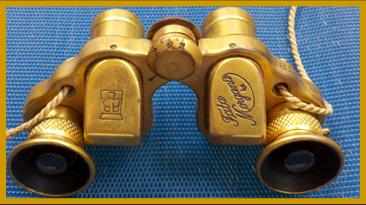

|
Gilded pair of brass 1920’s Fata Morgana 4x 12 binoculars, Engraved with family owner’s name. Origin: Cassel, Germany. Collection of Melanie Willis , USA, Photos Melanie Willis |
|
Gilded Fata Morgana Binoculars Vergoldetes „Fata Morgana“- Fernglas. Jumelles Dorées «Fata Morgana». Позолоченное «Fata Morgana» Бинокль. Fata Morgana 金 めっきされた双眼鏡 . «Fata Morgana» Prismáticos Chapado en Oro. Binocolo «Fata Morgana» Dorato in Miniatura. |
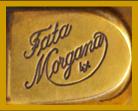


|
(approximate translation) “Get a copy of our Fata Morgana prism binoculars / Several new patents registered / a wonderful bright opera and travel binocular/ Carefully manufactured of first class material./ Warranted/ Is the smallest and lightest binoculars/ 92mm greatest diameter for Your Pocket/ Only 75 grams / 4 power magnification/ Field of View 20 meters at 100 meters/ each eyepiece and the papillary distance is adjustable. Price 75 francs/ You secure a copy immediately at the FATA MORGANA COMPANY. Biel 12, shipping cash on delivery or postal check or advance payment. Biel 1 VA 1024 “ |
|
Fata Morgana Binoculars with Handle,1919 Swiss Ad. Miniaturfernglas „Fata Morgana“ mit Haltegriff, Zeitungsannonce Schweiz, 1919. Jumelles «Fata Morgana» Avec Poignée, 1919 Annonce Suisse. «Fata Morgana» Бинокль с ручкой, 1919 года швейцарский реклама. «Fata Morgana» Prismáticos con Empuñadura, Anuncio de Suiza 1919. «Fata Morgana» binocolo con manico, 1919 Pubblicà Svizzera. |
|
Dec 1919 Swiss advertisement suggests initial production was around the end of 1919, which matches the patent filings, and the trademark claims that the use of the name started in early 1919. Collection of Mark Ohno. Note lack of “ABC” Logo in drawing |
|
If my math is correct, by changing 1919 Swiss francs to 1919 US dollars, and then changing 1919 US dollars to 2010 US dollars, the price was around $181.26 in equivalent 2010 US dollars. |


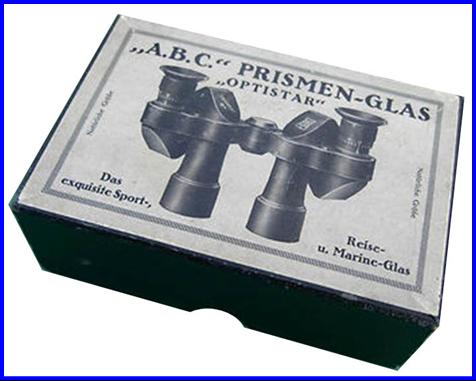
|
Original Optistar pasteboard box. Collection of Mark Ohno. Box sourced in Germany . („Optistar“ Originalkarton) |


|
Collection/Photo courtesy of Marc in Montevideo Uruguay |
|
Two Earliest Known Fata Morgana Binoculars (serial # 520, & #680 ). Älteste Bekannte „Fata Morgana“ Ferngläser mit Tatzenkreuz-Dekor, Seriennummer 520 und 680. Premièrs Jumelles «Fata Morgana», Numéro de Serie 520 et 680. Два первых известных «Fata Morgana» бинокль. Серийный номер 520 и 680. Dos de los Primeros Prismáticos Conocido «Fata Morgana»: Número de Serie 520 y 680. Due Binocoli Più Conosiuti «Fata Morgana» : Numeri di Serie 520 e 680. |
|
Pending future discovery, these two pairs of Fata Morgana binoculars are currently the earliest known surviving examples (serial numbers 520 and 680), and they have a number of interesting features that are not found on other known examples. I believe these were probably manufactured in 1919. They lack the ABC marking found on all other documented Fata Morgana binoculars, but the ABC is also absent in the 1919 Swiss advertisement. On these binoculars the barrel of the objective lens pack fouls the prism covers, requiring a relief cut. Later examples changed the geometry so that the barrels have enough clearance. These Fata Morgana binoculars have a hand stamped design embellishment all over of the Tatzenkreuz (foot cross), or Cross Pattée (footed cross), sometimes also known as the “iron cross” or Eisernes Kreuz after the German WWI and WWII military honor medal of that design. (nearly five and a half million German iron cross medals were estimated awarded in WWI). In 1919 the recent war was an all pervasive influence in Germany. Approximately 13.4 million Germans served in the military, or 20% of the total population. Germany had 5 million military casualties and 2.1 million military deaths. Personal items commemorating WWI in some way are common, and those incorporating the Tatzenkreuz or Eisernes Kreuz is very common on German items. But the symbol was also a generic Christian religious symbol associated with the Knights Templar, and something sold in the US in 1919 decorated this way would not necessarily have been associated with the German medal (as would certainly have been the case within Germany). Focus is accomplished on these binoculars by sliding a pin in an angled slot, to cam the diopter in and out of its barrel. Later models internally work in a similar fashion, but use a focus ring and pin, and the ring is much easier to grasp while looking through the binoculars. It is quite difficult to get a finger on the pin and slide it while viewing on these early models. With neck string these binoculars weigh 76.5 grams, close to the 75 grams claimed by the advertisement, and is reflective of their (unpainted) aluminum construction. By comparison, the gilded Fata Morgana of brass construction binoculars weighs a hefty 150 grams. By sometime in 1920 a revised focus mechanism with ring was pictured, so these binoculars are probably from1919, the first year of production. |
|
Circa 1919 Fata Morgana 4x binoculars, serial number 680, Origin: Cassel, Germany. Binoculars Sourced in the UK Collection of Mark Ohno , USA Photos Mark Ohno |


|
Focus mechanism of pin and slot to cam internal diopter in and out. okussiermechanismus : der innenliegende Diopter wird über Knopf und Führungsschlitz bewegt. |
|
Relief clearance cut into the objective barrel. |


|
The 1919 advertisement clearly shows the pin and slot focus mechanism, and also has no ABC emblem, so it is reflective of the configuration found on binocular serial # 680 |
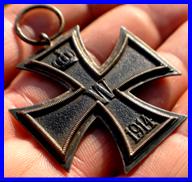
|
German WWI Iron Cross Medal Collection Mark Ohno Deutscher Militärorden „Eisernes Kreuz” (1WK). Sammlung Mark Ohno |


|
Ecker Marked Optistar 6x Binoculars (serial # 43820) „Optistar“-Fernglas der Schweizer Vertriebsfirma Ecker, Luzerne. (Seriennummer 43820). Jumelles «Optistar»— Marqué de Distributeur Ecker Luzern, 43820. Ecker отмечен «Optistar» бинокль. Серийный номер 43820. Ecker Marcado Prismáticos 6x «Optistar», Número de Serie 43820. Ecker Contrassegnato Binocoli «Optistar» (Numero di Serie 43820). |
|
W. (William) Ecker of Kapellplatz 10 Luzern (Lucerne) Switzerland was a photographic supply co. and Opticians They appear in 1913 and 1922 directories by Karl Baedeker covering Switzerland, Italy, Savoy, Tyrol, & Chamonix. The firm is known to have branded opera glasses, barometers, thermometers and similar items with their name. It seems to indicate the first distributor branding of this type of miniature binoculars. The firm Ecker AG still occupies Kapellplatz 10, 6004 Luzern Switzerland in 2012. Pending (probable) future discoveries: this is one of the only three known examples of a private branded or dealer marked Fata Morgana or Optistar binocular (the others being the Prinzess Fata Morgana variant and Dutch East India dealer Bünger marked Fata Morgana), and is the second latest (newest) documented Optistar binoculars to be manufactured according to the serial number. |


|
Ecker Luzern private branded Optistar 6x binoculars, Origin: Cassel, Germany. Serial number 43820. Binoculars Sourced in the UK Collection of Mark Ohno |

|
Black Fata Morgana 4x Binoculars with Opera Glass or Lorgnette Handles (serial number #14133 & 212268) Fata Morgana“-Fernglässer (4x) mit schwarzem Handgriff, Seriennummer 14133 & 21228. Jumelles «Fata Morgana» Noires Avec Manches de Lorgnette de Spectacle, Numéro de Serie 14133 & 21228. Черный «Fata Morgana» бинокль с телескопической ручкой. Серийный номер 14133, 21228. Negro «Fata Morgana» Prismáticos con una Empuñadura, el Número de Serie 14133 & 212218 . Binocolo Nera «Fata Morgana» 4x con Maniglie (Numeri di Serie 14133 e 212268). |
|
Black Fata Morgana 4x binoculars with telescoping handle. Serial #14133 „Fata Morgana“-Fernglas (4x) mit schwarzem Teleskop-/Lorgnette Handgriff Seriennummer 1433. Origin: Cassel, Germany. Binoculars Sourced in United States Collection of Mark Ohno |

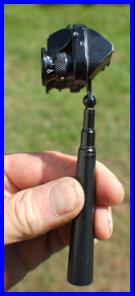



|
Two black Fata Morgana binoculars with opera glass or Lorgnette telescoping folding handles. At the moment these plus serial #11432 are the only known examples in black with black handle, otherwise similar to the guilded Fata Morgana with handles, except the body is not brass, and the black models have a more simple friction folding mechanism that does not lock in place. I believe that only a small portion of Fata Morgana binoculars were made with a handle, but since the 1919 ad shows a lady with Fata Morgana binoculars with handle, this “opera” or “theater” configuration must have been intended from the beginning. |
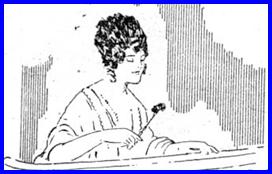

|
William Ecker in 1925 |

|
Kapellplatz 10, Lucerne (2012) |
|
Serial #14133 |
|
Silver color Fata Morgana 4x Binoculars with Opera Glass or Lorgnette Handles (serial number #8383), & Straw Pattern Decoration . Silberfarbenes „Fata Morgana“-Fernglas mit Handgriff, Strohdekor. (Seriennummer 8383) sowie Strohmusterdekoration Jumelles «Fata Morgana» en Aluminum—Motif de Paille—avec Manches de Lornette de Spectacle. Серебристый «Fata Morgana» бинокль с ручкой и соломы оформление.Серийный номер 8383. Prismáticos «Fata Morgana» Color Plata, con una Empuñadura, el Número de Serie 8383, con Decoración de Paja. Colore Argento «Fata Morgana» 4x binocolo con Maniglie (Numero di Serie 8383) e Decorazione con motivo di Paglia. |
|
Silver (aluminum) Fata Morgana 4x binoculars Lorgnette handle and straw pattern decoration ser# 8383„ Fata Morgana“-Fernglas mit handgriff, silberfarben mit Strohdekor. Origin: Cassel, Germany. Binoculars Sourced in United States Collection of Mark Ohno |
|
Fairly early production (serial no 8383) silver (unpainted aluminum?) Fata Morgana binoculars with opera glass or lorgnette telescoping celluloid faux ivory folding handles, and with a “straw pattern” embossed design. The handle uses an adaptor plate to attach to frame of the binoculars. Pending possible future discoveries: this is the only known example of a silver color Fata Morgana with handle, and one of only two known Fata Morgana binoculars with straw pattern embossing (the other serial #13202), the 5th oldest documented surviving Fata Morgana binocular, one of two Fata Morgana binocular observed with the serial number on a prism cover rather than stamped into the frame, and the first pin & ring focus example. As found, it is missing 2 prism covers and one prism, probably reflecting a botched repair attempt. Both oculars were seized, one or the few Fata Morgana or Optistar binoculars I encountered with that issue. |






|
Silver Color Fata Morgana 4x Binoculars (serial numbers #6511 & 10539) with Circle Pattern Decoration. „Fata Morgana”- Fernglas(4x), Aluminium , Silberfarben mit Kreisdekor (Seriennummer 6511, 10539). Jumelles «Fata Morgana» (En Aluminum) Motif Circulaire, Numéros de Série 6511, 10539. Серебристый цвет Fata Morgana бинокль с круглой оформление. Серийный номер 6511, 10539. Fata Morgana 4x Verrekijker Met Cirkelpatroon Met Behuizing #6511, 10539. Color Plata 4x Prismáticos Fata Morgan 4x Verrekijker Met Cirkelpatroon Met Behuizing #6511, 10539. (Número de Serie # 6511, 10539) con Patrón de Círculo Decoración. Color Plata Fata Morgana Prismáticos 4x Números de Serie 6511, 10539 con Patrón de Círculo Documentación. Colore Argento «Fata Morgana» 4x Binocolo (Numeros di Serie 6511,10539) con Decorazione Circolare. |
|
Fata Morgana 4x binoculars, silver (aluminum) with circle pattern embossing, serial # 10539. Origin: Cassel, Germany. Binoculars Sourced in Holland. Collection of Nico Westphal, Netherlands Photos courtesy Ted Brink, Photos© Ted Brink |



|
Der Fermenname „Ecker“ auf einem ”Optistar“- Fernglas. |
|
1919 Swiss Advertisement for Fata Morgana binoculars showing handle. Schweizer Annonce für „Fata Morgana“-Fernglas mit Handgriff ,1919. |
|
focus ring |
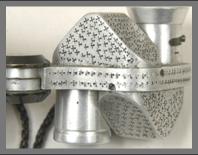
|
EARLIEST FATA MORGANA DOCUMENTED TO DATE Circa 1919 Fata Morgana 4x binoculars, serial number 520 Origin: Kassel, Germany. Collection of Jack Kelly, USA Photos courtesy of Jack Kelly |


|
Ältestes dokumentiertes „Fata Morgana”-Fernglas, Seriennummer 520, ca 1919. Herkunft: Kassel, Deutschland. Sammlung Jack Kelly, USA. Fotos: Eigentum von Jack Kelly. |
|
Using Fata Morgana binoculars. „Fata Morgana“ Ferngläser im Gebrauch.Jumelles «Fata Morgana» en cours d’utilization. |

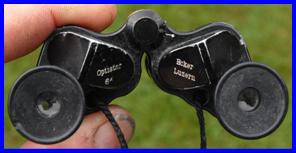
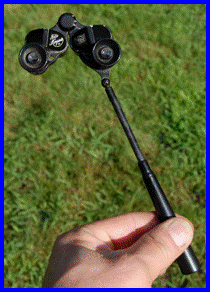

|
Fata Morgana 4x reverse poro prism miniature binoculars were invented by Alfred Baumann in 1919 |



|
Fata Morgana 4x Miniature Binoculars Das miniaturfernglas „Fata Morgana“. «Fata Morgana» jumelles Miniatures. «Fata Morgana» Миниатюрные Бинокль. Fata Morgana ミニチュアの双眼鏡 . «Fata Morgana» Prismáticos en Miniatura. Binocolo «Fata Morgana» in Miniatura. |


|
Typical late production Fata Morgana 4x Binoculars. Serial number 25071. Collection of Mark Ohno |
|
Typical mid production Fata Morgana 4x Binoculars. Serial number 17360. Collection of Mark Ohno |





|
Black Fata Morgana 4x binoculars with telescoping handle. Serial #21228 „Fata Morgana“-Fernglas (4x) mit schwarzem Teleskop-/Lorgnette Handgriff Seriennummer 21228 Origin: Cassel, Germany. Binoculars Sourced in United States Collection of Mark Ohno |


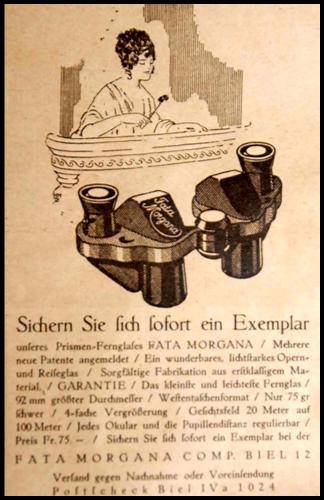

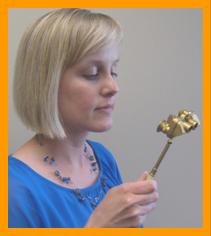






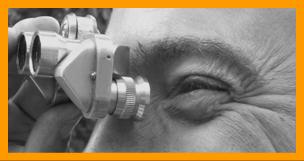
|
4x |
|
GENERAL WEBSITE UDATE December 19, 2025 AS OF 12/19/2025 37,511,479 VIEW S OF WEBSITE |




|
Pending future discovery, these Optistar 6x binoculars from the UK with serial # 35123 are the earliest known Optistar binoculars; are 6 numbers after the last known 4x fata Morgana binoculars having serial #35117, and are 1,523 numbers before the only known Fata Morgana 6x binoculars. (It is unknown if 4x Fata Morgan and 6x Optistar serial numbers overlapped in duplication). |
|
CHK - C ross H atch K nurl ring, VK - V ertical K nurl ring, WP -ring W ith P in, NP -ring N o P in, blk -black, sil -silver, NA - N ot A vailable BE - B aklite one piece E yepiece, 6F -6mm F rame, 6.6F –6.6mm 7F -7mm frame, 10F -10mm frame, SNPC -Serial N umber on P rism C over |
|
Fata Morgana 4x binoculars. Ferngläser „Fata Morana“ 4x . Les Jumelles «Fata Morgana» 4x . «Fata Morgana 4x» Миниатюрные б инокль. «Fata Morgana» Prismáticos 4x . |
|
Serial # 520 (pin & slot, sil) Tatzenkreuz embossing collection of Jack Kelly, USA Serial # 680 (pin & slot, sil, 6F) Tatzenkreuz embossing collection of Mark Ohno, USA Serial # 1491 (pin & slot, blk) auctioned Spain Serial # 3880 w/lorgnette handle collection of Matthew Williamson Serial # 4985 (pin & slot, blk) auctioned UK 2022 Serial # 6075 (pin & slot, blk, 6F) collection of Mark Ohno, USA Serial # 6075 (pin & slot, blk, 6F) collection of Mark Ohno, USA Serial # 6301 pin & slot, blk), ABC & Fata Morgana one prism cover auctioned Italy 2019 Serial # 6322 (pin & slot, blk, 6F) collection of Mark Ohno, USA Serial # 6322 (pin & slot, blk, 6F) collection of Mark Ohno, USA Serial # 6532 (VK, sil, WP, 6F) straw pattern, Mark Ohno USA Serial # 6548 (pin & slot, blk), ABC & Fata Morgana one prism cover auctioned Germany 2018 Serial # 8383 (VK, sil, WP, 6F, SNPC) straw pattern, w/lorgnette handle Mark Ohno USA Serial # 8438 (VK, sil, WP, 6F) straw pattern , auctioned USA 2022 Serial # 8766 (VK, blk) WP) auctioned Lithuania 12/2015 Serial # 9303 (VK, blk) WP) Geoff Stone UK Serial # 9532 (VK, blk) WP) auctioned Norway 9/2013 Serial # 9585 (config. NA) observed private collection Serial # 9613 (VK, blk) WP, 6F), SNPC collection of Mark Ohno, USA Serial # 9614 (VK, blk) WP, 6F), SNPC collection of Mark Ohno, USA Serial # 9755 (config. NA) list of Dr Hans Seeger, Hamburg, Germany Serial # 9804 (VK, blk, WP) collection of Imperial War Museum, UK Serial # 10048 (VK, blk, WP,6.6F) collection of Mark Ohno, USA Serial # 10202 (VK, blk, WP,7F) collection of Mark Ohno, USA Serial # 10498 (VK, blk, WP) auctioned in UK 2018 Serial # 10539 (VK, silver, WP) circle pattern embossing ) collection Nico Westphal, NL Serial # 10780 (VK, blk, WP) collection of Mark Ohno, USA Serial # 10877 (VK, blk, WP) auctioned Germany 6/2016 Serial # 11019 (VK, blk, WP) collection of Nico Westphal, Netherlands Serial # 11060 (VK, blk, WP) auctioned UK 2018 Serial # 11159 (VK, blk, WP) auctioned UK 2022 Serial # 11271 (VK, blk, WP , 7F) collection of Mark Ohno, USA Serial # 11432 (CHK, blk, WP) w/ lorgnette handle ) collection of Nico Westphal, NL Serial # 11806 (VK, blk, WP ) auctioned 2022 Serial # 11808 (VK, blk, WP ) auctioned UK 2022 Serial # 11900 (VK, blk, WP ) auctioned UK 5/2013 Serial # 11908 (VK, blk, WP ) auction Spain 2018 Serial # 12144 (VK, blk, WP ) auctioned UK 3/2014 Serial # 12278 (blk) list of Dr Hans Seeger, Hamburg, Germany Serial # 12679 (VK gilded, WP, 6.6F) w/ lorgnette handle collection of Mark Ohno, USA Serial # 12691 (VK gilded, WP, 6.6F) w/ lorgnette handle collection of Mark Ohno, USA Serial # 12925 (VK, blk, WP ) collection fernglasmuseum.at Serial # 12925 (VK, blk, WP ) collection in Spain Serial # 13203 (VK, sil, WP) straw pattern embossed, Mark Ohno USA Serial # 13407 (CHK gilded, WP,) w/ lorgnette handle auction UK 2015, for sale Russia 2018 Serial # 13730 (VK, blk, WP ) auction Spain 2018 Serial # 14133 (CHK, blk, WP, 7F) w/ lorgnette handle collection of Mark Ohno, USA Serial # 14211 (CHK, blk, WP, 7F) collection of Mark Ohno, USA Serial # 14398 (CHK, blk, WP, 7F) collection of Mark Ohno, USA Serial # 14420 (gilded, WP) list of Dr Hans Seeger, Germany Serial # 14441 (blk, WP,7F) collection of Mark Ohno, USA Serial # 14491 (blk, WP, ) collection of Mark Ohno, USA Serial # 14494 (CHK, blk, WP, 7F) collection of Mark Ohno, USA Serial # 14712 (CHK gilded, WP) w/ lorgnette handle collection of Ulrich Zeun, Germany Serial # 14716 (CHK gilded, WP, 6.6F) collection of Mark Ohno, USA Serial # 14971 (CHK gilded, WP, 6.6F) w/ lorgnette handle collection of Mark Ohno, USA Serial # 14985 (CHK, gilded, WP) collection of Melanie Willis, USA Serial # 15084 (CHK gilded, WP) w/ lorgnette handle , auctioned Spain 8/2013 Serial # 15105 (CHK, gilded, WP, 7F) collection of Mark Ohno, USA Serial # 15286 (gilded,WP) auctioned in UK 2011 Serial # 15310 (CHK, blk, WP,7F) collection of Mark Ohno, USA Serial # 15504 (CHK, blk, WP) collection of Nico Westphal, Netherlands Serial # 16224 (CHK, blk, WP) auctioned Ebay UK 2018 Serial # 16439 (CHK, blk, WP, 7F) collection of Mark Ohno, USA Serial # 16794 (config. NA) auctioned Ebay 2007 Serial # 16847 (CHK, blk, WP) auctioned Etsy 2021 Serial # 17100 (CHK, blk, WP) collection of Matt Williamson Serial # 17218 (CHK, blk, WP, 7F) collection of Mark Ohno, USA Serial # 17360 (CHK, blk, WP.7F) collection of Mark Ohno, USA Serial # 17472 (CHK, gilded, WP) auctioned France 2017 Serial # 17578 (CHK, blk, WP) collection of Mark Ohno, USA Serial # 17601 (CHK, blk, WP) collection of Anna & Terry Vacani, UK Serial # 17976 (blk) list of Dr Hans Seeger, Hamburg Germany Serial # 18366 (CHK, blk, WP) autioned Germany 9/2013 Serial # 18588 (CHK, guilded,WP, 7F) collection of Mark Ohno, USA Serial # 18671 (CHK, gilded) collection Nico Westphal, Netherlands Serial # 19208 (blk, WP) collection of Leitz Museum, Germany Serial # 19503 (blk, WP) Auctioned Ebay 2013, UK Serial # 20262(CHK, gilded, WP) auctioned Netherlands 3/2017, then Russia 2018 Serial # 20241 (CHK, gilded, WP, 7F) w/ lorgnette handle collection of Mark Ohno, USA Serial # 20262 (CHK, gilded, WP) for sale in Russia 2018 Serial # 20479 (CHK, gilded WP) auction USA 11/2020 Serial # 20524 (CHK, gilded, WP) auction Germany 10/2012 Serial # 20535 (CHK, gilded, WP) auction 2024 Serial # 20544 (CHK, gilded, WP) auction 2025 Serial # 20850 (CHK, blk, WP) auction Germany 4/2013 Serial # 20873 (CHK, blk, WP) collection of Ulrich Zeun, Germany Serial # 20950 (config NA, blk) collection of Günter Kampf, Germany Serial # 20955 (blk, WP, 7F) collection of Mark Ohno, USA Serial # 21228 (CHK, blk, WP) w/ lorgnette handle collection of Mark Ohno, USA Serial # 21830 (config NA) auctioned 2024 Serial # 21850 (config NA) auctioned Germany 2015 Serial $ 21905 (config NA) auctioned USA Nov 2012 Serial # 22366 (CHK, gilded WP 7F) w/ mother of pearl lorgnette handle collection Mark Ohno, Serial # 22421 (CHK, gilded WP 7F) collection of Mark Ohno, USA Serial # 22662 (VK, NP, blk) auctioned UK 2024 Serial # 23251 (VK, gilded WP 7F) collection of Mark Ohno, USA Serial # 23261 (blk) list of Dr Hans Seeger, Hamburg, Germany Serial # 24447 (NP, guilded) with box, collection of Mark Ohno, USA Serial # 24528(NP, guilded) collection of Mark Ohno, USA Serial # 24604 (NP, guilded, ) list of Dr Hans Seeger, Germany Serial # 24687 (gilded, WP) list of Dr Hans Seeger, Germany Serial # 24744 (gilded) list of Dr Hans Seeger, Hamburg, Germany Serial # 24654 (CHK, gilded, WP) auction 2025 Serial # 24792 (gilded) list of Dr Hans Seeger, Hamburg, Germany Serial # 24825 (gilded, VK) Czech auction site 2015 Serial # 24897 (BE, NP, VK, blk), Ebay Germany (Bayern Fürth)1/2014 Serial # 25071 (BE, NP, VK, blk, 10F), blk collection of Mark Ohno, USA Serial # 2517 (BE, NP, VK, blk, 10F), blk collection of Mark Ohno, USA Serial # 25490 (config NA) auction USA 1/2012 Serial # 25261 (config NA) offered at auction Michigan, USA, 2012 Serial # 25419 (BE,NP, VK, blk) collection Per Corell, Denmark Serial # 25490 (BE, NP, VK ,blk) collection of Nico Westphal, Netherlands Serial #25573 collection Ken, UK Serial # 25585 (config. NA) private collection Serial # 25708 (config. ) list of Dr Hans Seeger, Hamburg, Germany Serial # 25804 (BE, NP, VK, bNAlk,10F) collection Mark Ohno, sourced Prague Czech Replc. Serial # 28264 (gilded, VK) German auction site 2018 Serial# 28566 ) collection of Nico Westphal, Netherlands Serial # 28766 (BE, NP, VK, blk, 10F) collection of Mark Ohno, USA, sourced in the UK Serial # 28750 (BE, NP, VK, blk, 10F) marked “ made in Germany ” collection Mark Ohno, USA Serial # 28863 (BE, NP, VK, blk), collection of Per Corell, Denmark Serial # 29261 (BE, NP, VK, blk) collection of Mark Ohno, USA, sourced in Australia Serial # 35117 (BE, NP, VK, blk, 10F), marked to Dutch East Indies dealer Ludwig Bünger on Java, collection of Mark Ohno, sourced in Germany Serial # 44235 (BE, NP, blk10F) Prinzess private brand collection of Mark Ohno, USA No Serial no/ very late (BE, NP, blk10F) Prinzess private brand collection of Mark Ohno, USA
Based on lowest and highest observed serial numbers, production of Fata Morgana binoculars exceeded 43,7157 units
|
|
Fata Morgana 6x binoculars. Ferngläser „Fata Morgana“ 6x. Les Jumelles «Fata Morgana» 6x . «Fata Morgana 6x» Миниатюрные б инокль. «Fata Morgana» Prismáticos 6x . |
|
Serial # 36648 (BE NP) collection of Mark Ohno, USA |
|
Optistar 6x Binoculars. Ferngläser „Optistar“. Les Jumelles «Optistar». «Optistar» Миниатюрные бинокль. «Optistar» Prismáticos. |

|
Serial # 35123 (BE NP) collection of Mark Ohno, USA Serial # 38597 (BE NP) collection of Ulrich Zeun, Germany Serial # 39186 (BE NP) collection Anna & Terry Vacani, UK Serial # 39519 (BE NP) collection of Nico Westphal, NL Serial # 39612 (BE NP) auctioned 2019 Serial # 39552 (BE NP) collection of Mark Ohno, USA Serial # 39612 (BE NP) collection of Mark Ohno, USA Serial # 41292 (BE, NP) collection of Mark Ohno, USA Serial # 41314 (BE, NP) collection of Mark Ohno, USA Serial # 41431 (BE, NP) collection of Mark Ohno, USA Serial # 41435 Unmarked (BE, NP) collection of Mark Ohno Serial # 41534 (NA) auction UK 6/2013 Serial # 41692 (NA) auction Germany Serial # 41892 (BE,NP) auction Germany 1/2013 Serial # 42144 list of Dr Hans Seeger, Hamburg, Germany Serial # 42144 BE, NP) collection of Mark Ohno, USA Serial # 42190 (BE, NP) auction UK 2022 Serial # 42200 (BE, NP) auction UK 2018 Serial # 42473 (BE, NP) collection of Nico Westphal, NL Serial # 42556 list of Dr Hans Seeger, Hamburg Germany Serial # 42784 (BE, NP) collection of Mark Ohno, USA Serial # 43295 (BE, NP) collection of Nico Westphal, NL Serial # 43739 (BE, NP) collection of Mark Ohno, USA Serial # 43820 (BE, NP) Ecker private brand Mark Ohno, USA Serial # 43830 (BE, NP) collection of Mark Ohno, USA Serial # 44485 (BE, NP) collection Anna & Terry Vacani, UK
Based on lowest and highest observed serial numbers in this small sample, production of Optistar binoculars exceeded 9,362 units . |





|
Fata Morgana 4x binoculars, silver (aluminum) with circle pattern embossing, serial # 6511. Origin: Cassel, Germany. Binoculars Sourced in the UK. Collection of Mark Ohno USA |

|
Comparison of arly Optistar 6x binoculars (left above, and at top in RH picture) and Fata Morgana 4x. Binoculars. Vergleich eines jüngeren „Fata Morgana“-Fernglases (4x) mit einem „Optistar“ -Fernglas (6x). (das „Fata Morgana“ ist das obere bzw. rechte Fernglas). |
|
Early production (serial numbers 6511 &10539) silver (unpainted aluminum?) x x 4x12 binoculars with circle pattern embossed design. Pending future discoveries, the two known survivors of this decoration. Frühe Produktion (Seriennummern 6511 und 10539) aus Silber (unlackiertes Aluminium?) X x 4x12-Fernglas mit kreisförmiger Prägung. In Erwartung zukünftiger Entdeckungen sind die beiden bekannten Überlebenden dieser Dekoration. Production initiale (numéros de série 6511 et 10539) argent (aluminium non peint?) X x 4x12 jumelles avec motif en relief. En attendant de futures découvertes, les deux survivants connus de cette décoration. Раннее производство (серийные номера 6511 и 10539) серебро (неокрашенный алюминий?) Бинокль x x 4x12 с тисненым рисунком в виде круга В ожидании будущих открытий, два известных выживших этого украшения. Producción temprana (números de serie 6511 y 10539) de plata (¿aluminio sin pintar?) X x 4x12 binoculares con diseño de patrón de círculo en relieve. A la espera de futuros descubrimientos, los dos supervivientes conocidos de esta decoración. |
|
BINOCULARS RESEARCH WEBSITE, NOT FOR PROFIT FERNGLAS-FORSCHUNGS-WEBSITE, NICHT GEWINNORIENTIERT SITE DE RECHERCHE SUR LES JUMELLES, À BUT NON LUCRATIF |




|
MARK OHNO ミニチュア双眼鏡 миниатюрные бинокли |









|
FOR OUR MILITARY & FULL SIZE BINOCULARS see sections OTHER BINOCULARS & BIG & SMALL |
![Text Box: CLICK ON PAGE LINE. CLIQUEZ SUR LA LIGNE DE PAGE. KLICKEN SIE AUF SEITENZEILE. HAGA CLIC EN LÍNEA DE PÁGINA..[ページ行]をクリックします。НАЖМИТЕ НА СТРОКУ СТРАНИЦЫ. ALSO SEE INDEX.](image6052.gif)
